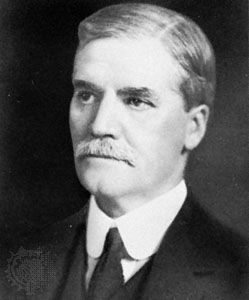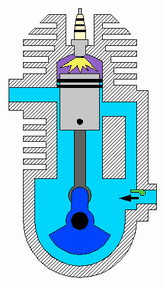A two-stroke engine is a type of internal combustion engine. It completes a power cycle with two strokes of the piston during only one crankshaft revolution.
Index
History
It was Dugald Clerk, a Scottish engineer, who created the design for a commercial two-stroke engine involving in-cylinder compression, in 1881.

Construction of Two-Stroke Engine
The construction of a two-stroke engine involves:
- Piston: The expanding forces of gases are transferred to the mechanical rotation of the crankshaft via a connecting rod, by the piston.
- Crankshaft: This part allowed the conversion of reciprocating motion to rotational motion.
- Connecting rod: This allows the motion of a piston to be transferred to the crankshaft.
- Flywheel: A mechanical device used to store energy.
- Spark Plug: Allows the expansion of gases by delivering electric current to the combustion chamber and igniting the air-fuel mixture.
- Counter Weight: This part is used to reduce the vibrations due to imbalances in the rotating assembly.
- Inlets and Outlets: Allows the enter and exit of fresh air into the cylinder.

Working of Two-Stroke Engine
The two-stroke engine cycle primarily is of two halves, up-stroke, and down-stroke.
In the up-stroke, the piston is pushed from Bottom Dead Center (BDC) to the Top Dead Center (TDC). This allows the fuel-air mixture to be compressed and the spark plug ignites the mixture.
This mixture then expands thus pushing the piston down. This opens the inlet port, letting the mixture get sucked inside the crankcase.
When the mixture is pushed up into the combustion chamber during the previous upstroke, a partial vacuum is created. This mixture goes into the combustion chamber during the down-stroke.
During the down-stroke, the piston moves from TDC to BDC. This allows the fresh air to enter the combustion chamber and mix with the fuel. It is observed that in this stroke, the crankshaft makes a rotation of 180°.
Types of Two-Stroke Engine
The different Type of Two-Stroke Engines are:
- Piston-Controlled Inlet Port: Simplest of all designs and most common.
- Reed Inlet Valve: Simple but highly effective form of check valve used.
- Rotary Inlet Valve: Uses a rotating member to open and close the intake pathway.
- Cross-Inlet Scavenging: The transfer and exhaust ports are on opposite sides of the cylinder and a deflector is used on top of the piston to direct the fresh intake charge into the upper part of the cylinder.
- Loop Scavenging: Uses carefully shaped and positioned transfer ports to direct the flow of fresh mixture toward the combustion chamber as it enters the cylinder.
- Uni-flow Scavenging: In this model, the charge air enters at one end of the cylinder controlled by the piston, and the exhaust exits at the other end.
- Stepped Piston Engine: It is of top-hat shape, the upper sections forming the regular cylinder and the lower section performing a scavenging function.
Applications
- Two-stroke engines are less expensive to build.
- They are used in chainsaws, weed-eaters.
- They are also used in off-road motorcycles and racing vehicles.
FAQs
The petrol engine uses petrol as fuel. In such engines, air and petrol are mixed in the carburetor before being passed into the cylinder. Petrol engines use spark plugs to ignite the mixture.
The diesel engine uses diesel as fuel and relies majorly on heavily compressed air. Diesel engines are much more cheap and efficient compared to petrol engines.
In a two-stroke engine, the entire combustion cycle takes place within just one piston stroke, whereas in a four-stroke engine the piston takes two complete strokes. Four-stroke engines are much more efficient than two-stroke engines due to fuel being consumed only once every 4 strokes.
A four-stroke engine is quiet compared to the high-pitched buzzing sound of two-stroke engines.
